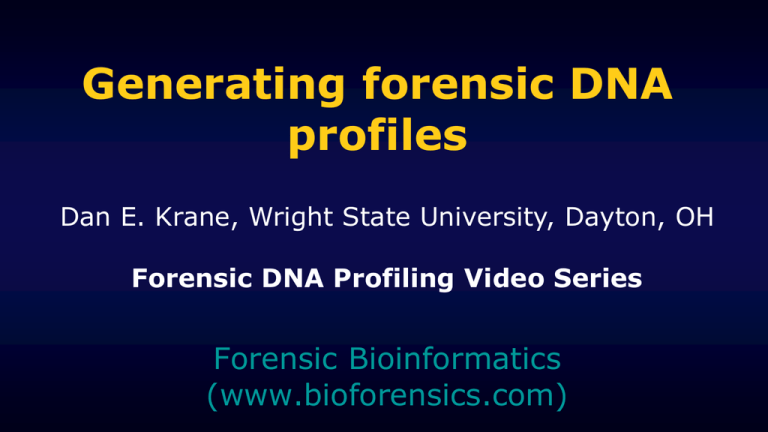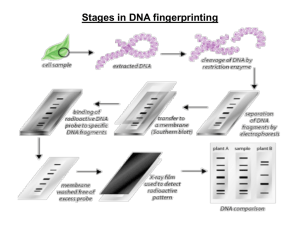
Generating forensic DNA
profiles
Dan E. Krane, Wright State University, Dayton, OH
Forensic DNA Profiling Video Series
Forensic Bioinformatics
(www.bioforensics.com)
Three generations of DNA testing
RFLP
AUTORAD
Allele = BAND
DQ-alpha
TEST STRIP
Allele = BLUE DOT
Automated STR
ELECTROPHEROGRAM
Allele = PEAK
Two additional DNA tests
Mitochondrial DNA
mtDNA sequence
Sensitive but not
discriminating
Y-STRs
Useful with mixtures
Paternally inherited
DNA content of biological samples
Trillions of cells
Roughly 100
cells
Each cell contains 6 to 7 pg of DNA
DNA profiling kits generally recommend using
between 500 and 1,000 pg of template DNA
That works out to roughly 100 to 200 cells
What is a picogram?
• 1 gram = 1/4th of a packet
of sugar
• 1 milligram = a single
crystal of sugar
• 1 nanogram = one 1000th
of a crystal of sugar
• 1 picogram = one billionth
of a gram
What is a microliter?
• 1 liter = half of a bottle of
a soft drink
• 1 milliliter = 1000th of a
liter (about a thimble full)
• 100 microliters = one drop
• 1 microliter = one
millionth of a liter
Basic terminology: Genetics
• DNA Polymorphism (“many forms”)
– Regions of DNA which differ from person
to person
• Locus (plural = loci)
– Site or location on a chromosome
• Allele
– Different variants which can exist at a
locus
Basic terminology: Technology
• Amplification or PCR (Polymerase Chain
Reaction)
– A technique for ‘replicating’ DNA in the
laboratory (‘molecular Xeroxing’)
– Region to be amplified defined by primers
• Electrophoresis
– A technique for separating molecules
according to their size
Automated STR Test
Crime Scene Samples &
Reference Samples
• Extract and purify DNA
Differential extraction in sex
assault cases attempts to
isolate DNA from sperm cells
Extract and Purify DNA
• Add primers and other reagents
Setting up an amplification
• Pipettors are used to transfer
microliter quantities of liquids
• Final reaction volumes are
typically 10 or 20 microliters
• There are no good visual clues
that a solution contains DNA or
that a reaction is proceeding
correctly
PCR Amplification
• DNA regions flanked by
primers are amplified
PCR Amplification
• Targeted regions are doubled
with each round of
amplification.
• Instead of needle in a haystack,
after 28 rounds of amplification
there is a needle-stack with a
piece of hay.
• Amplified DNA fragments are
fluorescently labeled.
The ABI 310 Genetic Analyzer
ABI 310 Genetic Analyzer:
Capillary Electrophoresis
•DNA pulled towards the
positive electrode
•DNA separated out by
size:
– Large DNA moves slowly
– Small DNA moves faster
•Color of STR detected
and recorded as it passes
the detector
Detector
Window
Profiler Plus: Raw data
Profiler Plus™ DNA profile
Reading an electropherogram
Peaks correspond to alleles
BLUEFGA
D3 vWA
Amelogenin
XX = female
XY = male
Red = ROX size standard
Electropherogram
D8
D21
GREEN
D18
Amelogenin
D5
D13 D7
YELLOW
75 100 139
150
160
200
RED
245
300 bps
Reading an electropherogram
NUMBER OF PEAKS
– 1 peak = homozygous
– 2 peaks = heterozygous
– 3 or more peaks =
mixed sample (?)
POSITION OF PEAK
– Smaller alleles on left
– Larger alleles on right
HEIGHT OF PEAK
– Proportional to
amount of allele
S
M
A
L
L
L
A
R
G
E
Profiler Plus
D3S1358
AMEL
vWA
D8S1179
D5S818
FGA
D21S11
D13S317
D18S51
D7S820
SGM+
D3S1358
AMEL
D19S433
vWA
D16S539
D21S11
D8S1179
THO1
D2S1338
D18S51
FGA
Profiler Plus™ DNA profile
What weight should be given to a
DNA profile match?
• Do they have the same
source?
• Is the match a
coincidence?
• Has an error occurred?
Generating forensic DNA
profiles
Dan E. Krane, Wright State University, Dayton, OH
Forensic DNA Profiling Video Series
Forensic Bioinformatics
(www.bioforensics.com)








